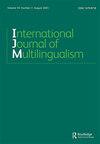从空间和时间的多样性中学习:挪威教师教育建筑符号学景观中的话语结构
IF 2
1区 文学
Q2 EDUCATION & EDUCATIONAL RESEARCH
引用次数: 3
摘要
本文章由计算机程序翻译,如有差异,请以英文原文为准。
Learnings from/about diversity in space and time: discursive constructions in the semiotic landscape of a teacher education building in Norway
ABSTRACT This article critically examines the discourses concerning historical and transnational linguistic and cultural diversity in the semiotic landscape of a new teacher education building in Norway. In 2020, this building, housing the Department of Education, opened at UiT The Arctic University of Norway, in the city of Tromsø. Designing, constructing, and decorating a new building for a national teacher education was taken as an opportunity to reflect on and negotiate the institution’s role in relevant contemporary, as well as historical, educational discourses and to mark a current standpoint. Taking a nexus analytical approach, we analyse how linguistic and cultural diversity are represented in the department’s public space and how this is interwoven with the construction of the institution’s position in a multilingual and multicultural environment. Our analysis shows that this diversity is constructed through various contrasts. Sámi identities and regional roots of knowledge are emphasised in the official part of the semiotic landscape – framed as learnings from diversity. However, by analysing meta-sociolinguistic discourses about diversity, we show that this is accompanied by the erasure of other aspects of linguistic and cultural diversity, in particular Kven culture and identity, transnational diversity, and children and their lifeworld.
求助全文
通过发布文献求助,成功后即可免费获取论文全文。
去求助
来源期刊

International Journal of Multilingualism
Multiple-
CiteScore
6.10
自引率
8.70%
发文量
67
期刊介绍:
The aim of the International Journal of Multilingualism (IJM) is to foster, present and spread research focused on psycholinguistic, sociolinguistic and educational aspects of multilingual acquisition and multilingualism. The journal is interdisciplinary and seeks to go beyond bilingualism and second language acquisition by developing the understanding of the specific characteristics of acquiring, processing and using more than two languages. The International Journal of Multilingualism (IJM) provides a forum wherein academics, researchers and practitioners may read and publish high-quality, original and state-of-the-art papers describing theoretical and empirical aspects that can contribute to advance our understanding of multilingualism.Topics of interest to IJM include, but are not limited to the following: early trilingualism, multilingual competence, foreign language learning within bilingual education, multilingual literacy, multilingual identity, metalinguistic awareness in multilinguals, multilingual representations in the mind or language use in multilingual communities. The editors encourage the submission of high quality papers on these areas as well as on other topics relevant to the interest of the International Journal Multilingualism (IJM). Reviews of important, up-to-date, relevant publications and proposals for special issues on relevant topics are also welcome.
 求助内容:
求助内容: 应助结果提醒方式:
应助结果提醒方式:


